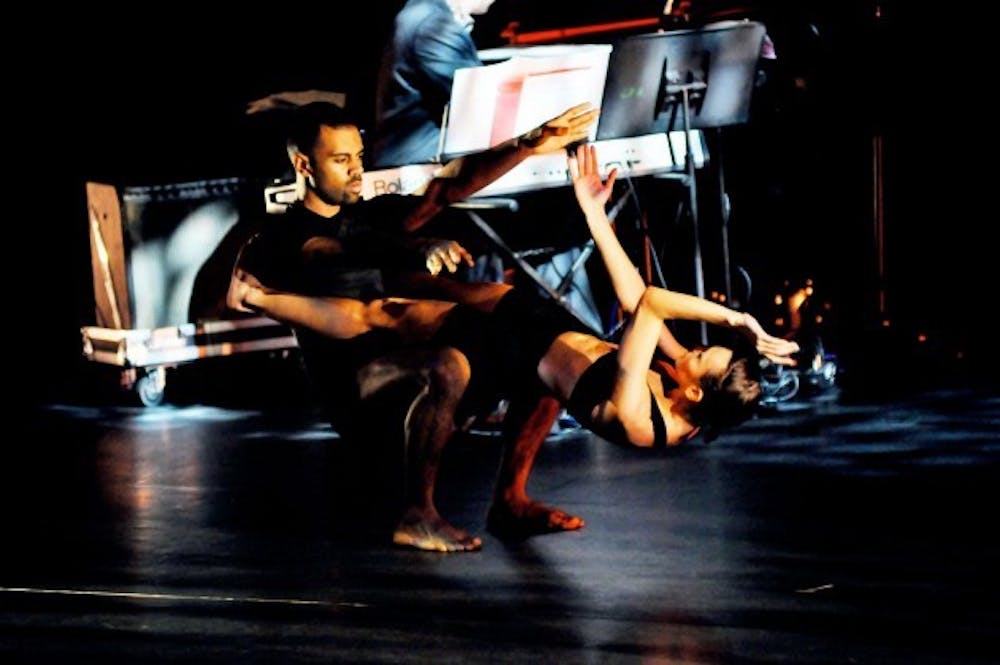Color, music, and movement came together in a one-of-a-kind show Thursday night at the Mainstage Theater.
Kaleidescopika: The Art of Unfolding is a collaborative effort by musical group Cordis and modern-fusion dance company LehrerDance. Cordis is a unique ensemble of traditional instruments and "one-of-a-kind creations" that combine to create their "signature sound." LehrerDance is a group that aims to translate "three main elements of movement" to their choreography: circularity, 3-dimensionality, and momentum.
From the outset of the show, the visual setup of the stage is jarring. Those expecting a traditional dance experience are shown four sets of musical instruments impeding upon the dance space in the shape of an obtuse diamond, leaving a limited area for unrestrained movement. Those expecting a traditional music experience are instantly thrown off balance by the spatial relationship of the instruments as well as the type of instruments being used, including a cimbalom and xylophone alongside the traditional cello and piano.
The musical strengths were evident from the show's beginning; well before it was disclosed that cimbalom player and Artistic Director of Cordis, Richard Grimes, and cellist Jeremy Harman composed all of the songs.
The diverse music ranged from quasi-discordant to almost symphonic, not only from song to song, but also from note to note. The juxtaposition of usual orchestral instruments against the very unfamiliar ones gave the music an almost otherworldly sound that was grounded only by the hearty percussion. The wielding of the cello was especially adept and affecting, and this instrument was the backbone of many songs.
The movement of the LehrerDance dancers illuminated modern dance conventions as well as a poetic blend of ballet-inspired fluidity and Martha Graham-like angularity. Lisa Kaemmerlen, a freshman dance major, noted that this fusion was particularly intriguing.
"I believe that strength was present among every dancer all the time," Kaemmerlen said. "Even if the movements were meant to be soft and slow, they were done with a lot of power."
The first piece featuring the dancers seemed to be the low-point of the medley among the typically strong choreography. Characterized by angular and directionless arm movements, this number failed to highlight the obvious technical and physical strength of the dancers, and the movement seemed awkward and contrived on the performers' lithe and muscular bodies. This opening piece also showed a disengaged understanding of the musical score, as the choreography seemed neither aligned nor at odds with the music, a weakness that could leave the audience feeling disconnected.
As the show progressed, however, the relationship between dancer and music became better defined. The choreography employed an impressive use of shape and a consciousness of level that corresponded to the musical progression and its unpredictable quality.
One of the strongest numbers was a quartet of the four female LehrerDance dancers. The visual quality of the movement in this piece demanded perfect synchronization – something the dancers achieved with absolute beauty.
Liquid yet pedestrian, light partner work and precise canons characterized this piece and although the stage space was limited, the dancers managed to use all four quadrants of the stage. This was a refreshing change from many other pieces that were restricted to thedownstage-most panels of marley.
Another notable performance was a male-female duet that featured intense partner work. Showcasing sheer athleticism and muscular development, the dancers performed almost superhuman feats. While one partner lay on his back with his feet to the ceiling, the other would place her entire body weight on the pads of his feet. The roles were also reversed: the woman partner would balance the entire male's weight on just her hands. Complex variations on classic partnering moves, like the "bluebird" lift, also characterized this powerhouse piece.
The primary weaknesses of Kaleidescopika were mainly technical. Tacky lighting effects that one might find in a middle school choir concert dominated the back scrim – green spider web- and finger print-like filters being a few such effects. The other potentially problematic issue was the placement of the musical instruments, which did at times seem constraining for the dancers. Otherwise, the show displayed artistic talent at its finest.
"I believe this show was the best I have seen from the group," said Kaemmerlen, who has seen LehrerDance before. "The way each movement connected into another and the way the dancers interact with each other is so pleasing to the audience."
As for the musical interaction, she said, "the live music on stage just added more depth to the show." Kaleidescopika proved to be an amazing way to connect to music and dance.
Email: arts@ubspectrum.com





